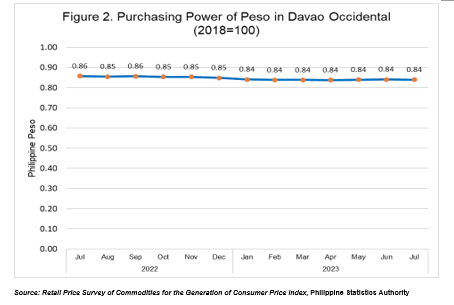
The Davao Occidental annual headline inflation slowed further to 2.1 percent in July 2023, from 3.1 percent in June 2023. This is the fifth consecutive month of deceleration in the headline inflation and the lowest since April 2022 with an inflation rate of 3.5 percent. The average inflation rate from January to July 2023 stood at 6.1 percent. In July 2022, the inflation rate was recorded at 8.1 percent. (Table A and Figure 1)
The continued downtrend of overall inflation in July 2023 was primarily brought about by the slower year-on-year increase in alcoholic beverages and tobacco at 20.8 percent during the month from 23.7 percent in June 2023. The slower annual increment observed in the heavily-weighted food and non-alcoholic beverages at 2.9 percent in July 2023 from 4.5 percent in the previous month also contributed to the downward trend of headline inflation. The third main source of deceleration was transport, recording a faster annual decrease of -11.8 percent during the month from -11.3 percent in June 2023.
Compared with their previous month’s inflation rates, slower annual increments were noted in the indices of the following commodity groups during the month:
Recreation, sport and culture, 11.7 percent from 11.8 percent;
Furnishings, household equipment and routine household maintenance, 7.8 percent from 7.9 percent;
Clothing and footwear, 3.4 percent from 3.5 percent;
Health, 2.0 percent from 2.9 percent; and
Housing, water, electricity, gas and other fuels, -0.2 percent from 0.0 percent.
The indices of the rest of the commodity groups retained their respective previous month’s annual growth rates. (Tables B)

For food and non-alcoholic beverages index, it declined to 2.9 percent from 4.5 percent in the previous month.
The reason of deceleration trend of the July 2023 inflation of food and non-alcoholics beverages group were contributed by the following groups;
- Sugar, confectionery and desserts from 36.6 percent to 18.3 percent;
- Milk, other dairy products and eggs from 12.5 percent to 11.3 percent;
- Ready-made food and other food products n.e.c. from 7.1 percent to 6.3 percent;
- Vegetables, tubers, plantains, cooking bananas and pulses from 5.7 percent to 4.8 percent;
- Fish and other seafood from 8.5 percent to 4.7 percent;
- Meat and other parts of slaughtered land animals from 0.8 percent to -4.0 percent; and
- Oil and fats from -33.4 percent to -33.9 percent.
On the other hand, cereals and cereal products had increased its index to 1.6 percent from 1.0 percent. While fruits and nuts retained at 0.7 percent. (Table C)



In addition, the July 2023 Purchasing Power of Peso (PPP) in Davao Occidental still remained at 0.84. (Figure 2)
Technical Notes:
Consumer Price Index (CPI) - The CPI is an indicator of the change in the average retail prices of a fixed basket of goods and services commonly purchased by households relative to a base year.
Inflation Rate (IR) - The inflation rate is the annual rate of change, or the year-on-year change of the CPI expressed in percent. Inflation is interpreted in terms of declining purchasing power of money.
Headline Inflation - measures changes in the cost of living based on movements in the prices of a specified basket of major commodities. It refers to the annual rate of change or the year-on-year change in the Consumer Price Index (CPI).
Purchasing Power of the Peso (PPP) - The purchasing power of the peso shows how much the peso in the base period is worth in the current period. It is computed as the reciprocal of the CPI for the period under review multiplied by 100.
Approved for Release:
JESSIE A. MADULIN
Chief Statistical Specialist
